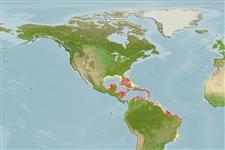Common names from other countries
Environment: milieu / climate zone / depth range / distribution range
Sinh thái học
Sống nổi và đáy; Mức độ sâu 0 - 25 m (Ref. 97531), usually 0 - 5 m. Tropical
Western Atlantic: USA to Brazil.
Length at first maturity / Bộ gần gũi / Khối lượng (Trọng lượng) / Age
Maturity: Lm ? range ? - ? cm Max length : 14.2 cm WD con đực/không giới tính; (Ref. 367); 9.5 cm WD (female)
Carapace slightly more than twice as broad as long; 9 teeth on arched anterolateral margin (outer orbital tooth and strong lateral spine included), second to eighth usually trending forward, without shoulders, anterior margins concave except first 2; front (excluding outer orbital angles) bearing 4 teeth, inner pair small but definitely formed. Anterior half of convex dorsal surface coarsely granulate, variably finer and more numerous granules on posterior on posterior part and in transverse lines; central trapezoidal (metagastric) area short and wide (anterior width about 2.4 times, posterior width about 1.5 times length). Pincers dissimilar, ridged longitudinally, fingers compressed but broadened dorsoventrally producing pointed spatulate shape; fifth legs flattened in form fifth legs flattened in form of paddles. Male with T-shaped abdomen reaching slightly beyond suture between thoracic sternites 4 and 5, sixth segment nearly parallel-sided but broadened proximally; first pleopods short, reaching about midlength of sternite 7, approximately each other or occasionally overlapping at level of abrupt curve beyond which short terminal part tapers to rather sharp tip; armed with minute scattered retrogressive spinules distally. Color: carapace brown with areas of bluish black. Chelae brown above; fingers dark on external face except for tips and proximal portion, internal face dark in distal 2/3; dark color of fingers retained in preservation.
Benthopelagic (Ref. 97531). Inhabits a variety of shallow environments to depths seldom exceeding 15 m, usually 5 m or less; found often in intertidal pools, on sand and muddy flats, algae and grass flats, sand beaches, rocky pools, eroded coral bases, oyster bars, shallows at edges of mangroves, and at the surface under light at night. Feeds on mollusks, other bottom invertebrates, and fishes, carrion and detritus (Ref. 367),
Life cycle and mating behavior
Chín muồi sinh dục | Sự tái sinh sản | Đẻ trứng | Các trứng | Sự sinh sản | Ấu trùng
Members of the order Decapoda are mostly gonochoric. Mating behavior: Precopulatory courtship ritual is common (through olfactory and tactile cues); usually indirect sperm transfer.
Tavares, M. 2003. (Ref. 367)
IUCN Red List Status (Ref. 130435)
CITES status (Ref. 108899)
Not Evaluated
Not Evaluated
Human uses
Các nghề cá: buôn bán nhỏ
| FishSource |
Các công cụ
Thêm thông tin
Age/SizeSự sinh trưởngLength-weightLength-lengthHình thái họcẤu trùngSự phong phú
Các nguồn internet
Estimates based on models
Preferred temperature
(Ref.
115969): 26.3 - 28.2, mean 27.4 (based on 546 cells).
Vulnerability
Low vulnerability (10 of 100).
